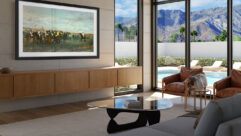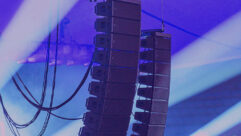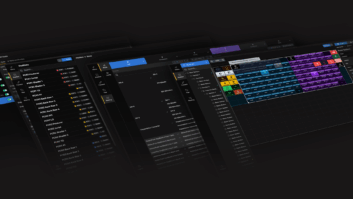
Houses of Worship — July 7, 2005
Jul 7, 2005 5:26 PM
Houses of Worship Top Story
Churches Adapt Small Line Arrays for Large Spaces
Line arrays have been commonplace at concerts, arenas, and other high-end venues for years now. But recently, houses of worship have been adopting line arrays as well—in increasing numbers.
In part, the trend is driven by the availability of a new generation of small, lightweight, high-power line array loudspeaker systems, marketed by virtually all of the leading manufacturers. In addition, though, the design flexibility of line arrays has often proved to be the answer to the oddly shaped rooms, combined speech/music reproduction, echoes, high ceilings, and other challenges that abound in the church environment.
Often, line arrays appeal to church AV designers because of architectural features of contemporary churches, which often include hard, reflective surfaces and highly varied building footprints. EAW, for example, recently provided its DSA Series line arrays for the renovation of the sanctuary at Northway Christian Church in Dallas.
After removing acoustic panels and carpet, the church leaders realized sound was bouncing off the bare floor and walls. According to EAW, more than three seconds of echoes and 1.25 seconds of reverberance had been added to the audio mix. But the EAW line arrays were able to steer sound output directly at portions of the congregation, avoiding much of the reflectivity.
Sheridan Hills Church in Hollywood, Fla., faced a similar challenge in expanding its facilities to accommodate rapid growth. Consultant Lee Buckalew of Pro Sound Advice, St. Louis, worked with the church to choose new audio systems to support not only the main Worship Center but also a variety of activities in other facilities on campus.
The main sanctuary at Sheridan Hills seats 1,200 and Sunday services feature a 25-member orchestra and 65-voice choir, along with a worship leader playing a guitar with wireless connection. The first decision was to replace the church’s unreliable audio consoles with two new Yamaha DM2000s—one in the main Worship Center and one in the Ministry Center, which houses the Spanish and Haitian services, youth services, and special events.
Next, they turned their attention to loudspeakers. Buckalew recommended a new Martin Audio product, the “very compact” W8LM line array. Three arrays of six cabinets each were flown above the platform. The combination of high-quality output with light weight and small size proved very appealing, Buckalew says.
Tom Young of Electroacoustic Design Services in Oxford, Conn., says these small systems are increasingly popular with churches. “In all but very large spaces, the medium and small multiband line array systems are certainly more often employed,” he says. This purchase decision, though, can be more complex than many realize, he adds.
“Houses of worship are, more often than not, less technically informed and may be more susceptible to being bamboozled or more likely to make the wrong choice, including incomplete design,” he continues. “Among the wrong choices to be made is, first of all, employing a line array in a space that does not work with line arrays. Another is overlooking the inherent restrictions in horizontal coverage that line arrays exhibit.”
Quality and versatility are increasingly combining to make mini-line arrays a popular choice for church audio systems. But before investing in speakers, churches should invest in getting some good advice and professional design.
Installation News
Sheridan Hills Church Gets Superior Sound with Martin Audio Line Array
A year ago, Travis Groat, the technical director of Sheridan Hills Church in Hollywood, Fla., called Professional AV Consultant Lee Buckalew because the large church/campus needed an upgraded sound system. Groat had worked with Buckalew before Sheridan Hills, and he knew that Buckalew was the technical director for First Baptist Church of Arnold in Arnold, Mo., and that his firsthand experience as a working professional would be invaluable in truly understanding today’s more sophisticated church media needs.
Before getting to any specifics, Buckalew and Groat discussed how media and technology could best be used in each area of the Florida campus where Sheridan Hills is located. Both men looked at all of the spaces on campus beyond the proposed new construction before proceeding. “We wanted to anticipate future needs, both in terms of facility growth and evolving technology,” says Groat.
Always meticulous in planning and execution, Buckalew works hard with installers to ensure all of the required permitting and engineering specifications are properly handled with the client. For an installation, he requires the church’s media ministries to step in and provide the manpower required to get the job done. This not only saves the church money but also creates a sense of ownership and pride for the entire media ministry.
Keeping in touch with Sheridan Hills’ technical director, pastor, and worship leader throughout the design process was critical. The church’s ministries are growing to the point where existing meeting places for Sunday morning services were soon to be too small. Examining the spaces where each ministry could meet and what it would require technologically proved to be a vital part of the design and implementation of the new Worship Center sound system.
Sheridan Hills’ main Worship Center seats approximately 1,200. The church recently added a second Sunday morning service so they could accommodate an increasing number of worshippers. Each Sunday morning service in the Worship Center includes a full 25-member orchestra and 65-member choir. The worship leader and his vocal team utilize a combination of wireless headsets and wireless handheld mics for vocals as well as a wireless connection for the worship leader’s acoustic guitar. The existing sound system, made up of a simple center cluster of four 60×90 co-axial cabinets with additional 60×90 front-fill horns and two double 15in. subs could no longer handle the needs of this growing service. In addition to this service, Sheridan Hills also has a Sunday morning Spanish service for 275, a Haitian service for 80, a Youth service for 170, and a Children’s service for 70. Each service is held in a different space and each represents its own set of technical challenges.
Each of these areas was initially designed to be integrated into a cohesive campuswide network of audio and video systems. Ongoing upgrades are being planned that will allow the various service locations around the campus to interface with each other for times of campus-wide corporate worship on Sundays as well as allow for interconnection of spaces for overflow or other needs during conferences and other large events.
It was decided that before the audio upgrade process could begin in earnest, the church had to upgrade their sound consoles. It chose Yamaha DM2000 digital consoles for the main Worship Center and Ministry Center. The church installed a basic 24-channel version of the DM2000 in the Ministry Center and a 56-channel version in the main Worship Center. Each of these consoles can be upgraded to a maximum of 96 inputs over time as future growth demands.
Buckalew and Groat worked together throughout while designing the new sound system to ensure that the final product would work for Sheridan Hills’ current and future needs. “Throughout the course of the year leading up to this system install, Travis and I looked at issues of miking for various instruments, monitoring for the orchestra, worship leader, and platform, and numerous other issues that could be handled one piece at a time,” says Buckalew.
To get the sound of the choir heard over the orchestra Buckalew recommended DPA 4011 microphones. “The DPAs provided an incredible improvement in our choral sound,” says Groat. Other changes made throughout the year included upgrading the wireless mic system with DPA and Countryman mics, a Sennheiser Evolution wireless system, and a range of Aviom personal monitor mixers.
The Worship Center presented challenging issues for a loudspeaker system because it was built years ago and had been extensively modified. “We had to determine if any of the existing drawings were accurate,” says Buckalew. Detailed measurements of critical areas were taken, and the designers were pleasantly surprised to discover a set of drawings with the updated construction.
The next challenge was using blueprints of manual drafting plates. “Normally we would take an electronic drawing and convert it to EASE format, so we could do acoustical calculations for various speaker systems and layouts” recalls Buckalew. “[Instead] we took the blueprints and hand drafted a series of overlays that allowed us to analyze the various coverage angles for the room. We then used Martin Audio‘s proprietary software program ViewPoint and laid out the initial system.”
Once this layout was finished, Buckalew sent hard copies of his drafting along with the ViewPoint data to Rob Hofkamp, Martin Audio’s director of operations for North America. Hofkamp forwarded all of this to Martin engineers, who confirmed Buckalew’s cabinet positioning and overall layout. “This made me feel great”, says Buckalew, “since I was working with a brand-new box that I had not had a chance to hear or use yet. That’s normally something that I would not do but, in this case, I was quite familiar with the two larger boxes in the Martin Line Array series, the W8L and the W8LC, and I was confident in the Martin development process, I knew that the W8LM would sonically match the larger boxes.”
There was a number of sonic or acoustic challenges as well. The Worship Center has four separate hemispherical walls in addition to many hard, reflective surfaces and almost no absorptive surfaces. The hard walls combined with the curved shape of some of the walls make for a room that has many problem areas due to beaming of the sound off the hemispherical walls and all of the reflections being generated between different hard surfaces. All of this combined to create a great deal of comb filtering, areas where the amplified sound was excessively loud and unintelligible, and other areas where the amplified sound was almost nonexistent. It was decided that Sheridan could not take on both the acoustic treatment of the room and a new sound system at the same time. The existing system, due to the design of the cluster, could not be made to work effectively in the room. It was subsequently decided that the sound system would be finished before the room was treated.

Pastor Ed Callahan, Sheridan Hills’ worship leader, had worked extensively with studio monitors from Martin’s former sister company, Tannoy, but had never heard a full Martin system before. “I knew the worship leader was a bit apprehensive,” says Buckalew, “so we arranged a demo of some Martin LE12JB floor monitors. They really needed new monitors, and they fell in love with them and bought them on the spot.” Callahan spoke with others who had utilized Martin systems and felt confident that this was the direction Sheridan Hills needed to go.
A flown LCR system was laid out with 18 Martin W8LM cabinets, six in each array. Four Martin WLX Sub Bass cabinets were designed into the system. The option of either ground-stacking or flying the subs was provided so that future planned changes in their video system could be easily accommodated. Four Martin WT-UB cabinets were specified for under balcony fill. “The side balconies in this space represented another challenge,” said Buckalew. “We were afraid that they would create significant acoustic shadows for two or three pews of congregation members.” Buckalew worked with Hofkamp and the engineers at Martin to customize two LE12JB monitors for the fill.
“I wanted to use the LE12JB’s because they utilize a differential dispersion horn,” says Buckalew. “Essentially this horn design means that, as you get farther from the box, sound pressure remains relatively constant because the horn’s compound angle is very broad when you are close to the box and it narrows as you are further away.
“As it turned out these were not needed. Once we installed the system we discovered, much to our delight, that only a few seats were missed on each side. We felt that adding these fills would cause more harm than help through phase problems being introduced to the room.”
“This system is the best-sounding that I have ever heard,” said Callahan, “all of the subtlety of the instruments is there, vocals come through clearly and cleanly and are easily understood without being harsh or too loud, and, most importantly for a church, spoken word, God’s word, is heard and understood at every seat in the room better than I ever expected it could be. We couldn’t be happier with the system.”
On Saturday afternoon the entire choir and orchestra came in to hear the system for the first time. “We had them sit front and center and played a number of different styles of music” says Groat. “After about five minutes people started getting up and, we thought, walking out.
“Well, we got up quickly and looked over the balcony edge (from where the DM2000 is) to see where people were going. It turns out that they were going to the places in the room where they usually sat on Sunday during the sermon.”
“Everyone had a smile on their face, I even got thumbs-up signs from older ladies in the choir,” says Buckalew. “No one could believe that that room could sound like that.” The next day was the first Sunday with the new system and there was not a single audio complaint. “That had not happened in the entire time I’ve been here,” says Groat. “In fact, there have been nothing but comments about how well everyone can hear now.”
The next step of sound treatment will finish the audio in this room for some time to come. “Right now” adds Groat, “even though the system is capable of maintaining over 115dB/SPL, we can only maintain about 90 to 94dB/SPL before the acoustic problems in the room begin to cause us severe sonic problems. We knew that we would have to treat the room but never dreamed that we could have a system sounding this good before we treated it. I can’t wait to see what this will sound like once the room is treated.”
Buckalew concludes, “I neglected to mention that the fantastic results we were able to obtain even before acoustically treating the room were due in part to the exceptional pattern control provided by the W8LM arrays but were influenced even more by the consistency of phase response provided by the mini arrays. Test measurements of coherence and phase response in the Worship Center after the installation showed an incredible increase in the coherence of sound and a smoother phase response curve throughout the room even with all three arrays driven.
“This is particularly interesting when you remember that the cluster that was replaced was a single center cluster. Most people would suggest that would provide for better coherence than three separate arrays. Tests showed that that was not the case.”

Innovason Delivers More Than the Word at Sight & Sound Theatres
Telling the great stories of the Christian faith on stage for more than 25 years, Sight & Sound Theatres has never let technology—or the lack of it—stand in its way. In the early 1970s, founders Glen and Shirley Eshelman used little more than a microphone, a turntable, a slide projector, and a rented hall outside the Lancaster County, Penn., township of Strasburg to stage their Wonder of It All tribute to their faith.
As their ambitions grew, the Eshelmans weren’t daunted either by the increasing audio and video technology needs that their ideas would ultimately demand. By 1976, the founders had their own home, the Sight & Sound Auditorium, which was outfitted with slide and film capabilities. By 1987, the full-length live production that stands today as the signature for Sight & Sound Theatres, Behold the Lamb, was up and running, using live actors and all the necessary AV accoutrements.
Today, some eight years following a devastating fire that destroyed the original theater but laid the groundwork for an even more magnificent structure, the technological envelope continues to be pushed. As the nation’s largest Christian theater, Sight & Sound continues to create spectacular live events, drawing hundreds of thousands of visitors from across the country.
One of the latest additions to the theater’s extensive portfolio of professional live sound gear is the Innovason Sy80 digital mixing console. Provided to Sight & Sound Theatres by Washington, D.C.-based systems integrator Washington Professional Systems, the state-of-the-art console is giving the theater an unprecedented degree of flexibility. The console is installed in the massive 2,000-seat Millennium Theatre, the anchor of the Sight & Sound Theatre complex that sports three stages and more than 85 loudspeakers. The theater produces elaborate stage events, which can include live animals, animatronic figures, life-size props, and even helicopters that fly in. The sheer number of microphones, combined with the vast number of scenes and settings, was a perfect match for the mixing and recall capabilities of the Sy80.
Gary Parke, audio operations supervisor at Sight & Sound Theatres, says the new Sy80 console is not only making the job of the sound engineers easier, but improving the quality of the presentations as well.
“The primary reason we bought the console was to increase the amount of microphones needed for our expanding shows,” Parke says. “With the old console we were limited to 32 wireless mics. Now, with the Sy80, we were able to bring in an additional 16 that are primarily used in one of our smaller theaters. The Sy80 also allows us to be able to easily handle the mixing requirements for all 48 mics, 32 of which are the Sennheiser 3000 Series wireless.” In addition, the desk simultaneously handles pre-recorded sound effects and music, in conjunction with another console dedicated to surround sound.
While the Sy80 provided the needed platform to expand the microphone count, Parke says it’s the console’s operational features that increase its value to the point where the theater can hardly imagine ever working without it.
“Its open architecture makes it very easy on the operator,” he says. “You have tremendous flexibility in routing mics to certain faders for certain scenes, making it easier to control the many mics needed for that scene. This makes it much more manageable for the operators to handle, versus having to have the mics spread out across a large analog console.”
Ease of programming also was a factor in the theater finally choosing the Sy80. “Setting up scenes is very easy, and everyone caught on to how to program it very quickly,” Park says. “There’s not a lot of page-flipping needed with the way the console is set up. It’s laid out very logically and elements for every scene are kept in close proximity. Our shows may have up to 15-plus mics just for dialogue with the bigger choral numbers employing 35 or so live mics. Once the mix is set up, scenes change automatically and productions stay very consistent. Trying to maintain that degree of consistency with multiple operators on a traditional analog console would have been tough.”
The Sy80’s scene recallability feature, made possible via the unique XFAD technology, enables each participant’s stored EQ to go directly to the right scene.
“The Sy80 has been a great addition to our theater,” he says. “It’s very flexible and easy to set up and I wouldn’t want to do a show without it.”
Product News

Inter-M Unveils Kensington Mixing Consoles
Available in frame sizes including 24-, 32-, and 40-channel models, the new Kensington Series of mixing consoles from Inter-M is being previewed this summer throughout the United States following the InfoComm debut of one of the line’s first functional engineering samples. With stylish looks, an ergonomic layout, rugged mechanical design, and a host of high-quality features, the Kensington product group is ideally suited for live sound reinforcement, theater, houses of worship, or any other application requiring a full-featured mixing console.
These new consoles bring together the expertise and experience of a renowned team of design engineers led by Miyajaki Yuichi of Inter-M and Dave Dearden of Audient plc. in the United Kingdom. Using its world-class manufacturing resources to transform the design vision into reality, Inter-M has effectively added a line of mixers to its catalog with outstanding audio performance, flexible facilities, and features.
Following a build concept forgoing the needless bells and whistles found on competitive offerings in favor of dedicating more resources to real-world functionality, the Kensington platform is based around individual modules instead of a master motherboard. Capable of being quickly changed to better facilitate future upgrades and service, the modules are mounted in groups of eight, making the overall architecture easily expandable from 24 channels to 32 and 40.
With 48V phantom power supplied individually at each of the desks’ inputs, other onboard features offered at each channel include a mic preamplifier of exceptional quality with low noise/distortion and high dynamic range, four-band “British EQ” equalizer with a pair of swept mid-band frequencies, sweep high-pass filtering, eight auxiliary sends with pre-fader switching, LCR panning, four mute groups, and direct outputs.
Dual-purpose in design, every Kensington console is additionally outfitted with Inter-M’s “Fader Flip” system, which provides “flip” capabilities at all the sub-groups and aux output, thereby making the desk perfect for applications where both FOH and monitor mixing operations need to be served by the same console. An optional meter bridge permits the viewing of all sub-group and main outputs, and 16-segment LED meters are offered on the operating surface as standard.
A total of six stereo returns are found on each Kensington model, each of which incorporates a three-band EQ section, a pair of aux sends, full sub-group assignment, and a solo system. To meet the demands of system design consultants, true LCR mixing is also provided, making the Kensington line ideally suited for high-end installations in auditoriums and churches.
“The Kensington’s true LCR mixing capabilities are ideal for houses of worship,” explains Inter-M Americas VP and general manager Doug Wilkens. “Music is best supported by stereo in church environments, while speech is best served by a center cluster. Therefore, it should come as no surprise that true LCR systems are being used in these applications more and more. By offering true LCR mixing, Kensington consoles provide control over LCR imaging you won’t find on other desks.”
A four-output matrix is also provided that is useful in many applications, as is a full talk-back system with presets made available at aux, group, and mix outputs. Even the internal signal generator has features that are unusual but extremely valuable such as a switchable-frequency tone generator and a pink noise generator.
Built for today with a keen eye for keeping pace with the future, the Kensington consoles respect every latest industry standard, including recently published AES standard AES48-2005, which addresses proper cable termination and grounding/shielding techniques. To meet the exacting requirements of critical applications, the power supply is additionally designed to function with a redundant supply for fail-safe backup.

NEC Display Solutions Introduces 32in. Addition to Family of Large-Screen LCD Public Information Displays
Poised to deliver the most affordable, feature-rich large-screen LCD on the market, NEC Display Solutions announced the availability of the LCD3210 large-screen LCD monitor. The new 32in. display not only includes NEC’s acclaimed Digital Signage Technology Suite (DSTS), but also features a new standard three-year limited warranty and an estimated street price of around $2,000.
Developed for applications in the rapidly emerging markets of information display and digital signage, the large-screen family of NEC displays offers the most technologically advanced functionality in the industry. With the smaller form factor, the LCD3210 is a perfect solution to deliver dynamic multimedia content to retail settings, conference rooms, and other applications that were previously unable to utilize larger LCDs. And, with the highest image contrast and brightness quality on the market, the new LCD3210 also delivers significantly improved visibility and color uniformity in high-ambient-light environments.
“The LCD3210 is now the most affordable, feature-rich large-screen LCD display on the market today,” says Hans Baumann, senior product manager for NEC Display Solutions. “The combination of a standard three-year limited warranty, a price point around $2,000, and many of the features and functionalities included in the DSTS suite should quickly make this display a must-have option for digital signage solutions.”
Key features in the DSTS suite such as higher power efficiency, lower internal temperature sensors and greater brightness control create a longer product life and a lower total cost of ownership in the LCD3210. This, along with the new three-year limited warranty, makes the new large screen an incredibly cost-effective digital information display solution.
“Digital signage solution providers and end users who want all the features and functionality of our bigger large-screen displays but require a smaller place or price will quickly see the LCD3210 is a great solution,” says Jeff Blankensop, regional manager for NEC Display Solutions. “This product really illustrates the depth and quality of NEC’s digital signage solutions portfolio.”
Significant to the NEC large-screen series is the incorporation of the company’s new Digital Signage Technology Suite, a new set of features and functions developed specifically for the digital signage market. Components in the new feature suite include the patented Tile Matrix feature that creates a near-seamless display for multi-unit applications. This feature eliminates the need for additional video distribution equipment such as distribution amplifiers and multi-head video cards. Matrices can be created resulting in ultra-large viewable images. The new displays also offer gray-to-gray overdrive, which allows for smoother, more uniform video image viewing.
Available in a full-function AV version, a basic feature IT version is also available for simple PC output applications. The NEC LCD 3210 is available for immediate delivery.

Furman’s High-Performance AR-15 Voltage Regulator Uniquely Includes Power Purification Capabilities
Furman Sound announced a new 15-amp voltage regulator that delivers a stable 120V of AC power to protect sensitive electronic equipment from damage caused by line voltage irregularities like sags, brownouts, and overvoltages. The AR-15 Series II is also the only voltage regulator that reduces line noise by filtering and purifying AC power to ensure optimum performance.
“Many voltage regulators on the market use motorized, transformer-based technology that not only make them large and expensive, but can actually increase the amount of noise in the line,” says Bob Cavin, vice president of engineering at Furman Sound. “Furman’s industry-leading technology has paved the way for the new AR-15, which delivers superior voltage regulation and noise filtration performance in a cost-effective, compact package.”
Often, voltage levels are inconsistent and can deviate significantly from the 120V on which electronic equipment is designed to operate. The AR-15 accepts any input voltage from 97V to 141V and transforms it to a constant 120V (±5) with an output capacity of 15amps. Additionally, sensitive electronics such as audio, video, and broadcast equipment can be severely damaged or destroyed by even the minor surges and
spikes that occur on a daily basis. Besides regulating the voltage level, the AR-15 protects connected equipment from damage using Furman’s exclusive SMP+ circuitry, which not only clamps and dissipates damaging transient voltages at the highest degree available, but does so without sacrificing itself so it can continue to do its job again and again without repair or replacement. Furman’s trusted over-voltage circuitry also protects against accidental connections to 208VAC or 240VAC by shutting off the incoming
power until the overvoltage condition is corrected.
In addition to protecting connected equipment, the AR-15 also filters and purifies AC power. It uses Furman’s Linear Filtering Technology (LiFT), which dramatically reduces noise that masks and distorts critical signal information, crippling performance. LiFT suppresses noise consistently across the entire dynamic range, and it is a vast improvement over typical AC filters utilizing nonlinear circuits, which reduce noise unevenly and can even add noise due to excessive resonant peaking.
The AR-15, with eight outlets on the rear panel and one on the front panel, is housed in a compact, single-space, rack-mount chassis. All outlets are regulated, spike-suppressed, and filtered against RFI and EMI. An LED bar-graph meter indicates the input voltage, while a separate LED indicates that the output voltage is within an acceptable range. An MSRP of $649.95 makes the AR-15 extremely cost-effective, and a three-year limited warranty covers defects in materials and workmanship.
Learn more about the AR-15 and Furman’s full range of voltage regulation and power conditioning products at www.furmansound.com.










